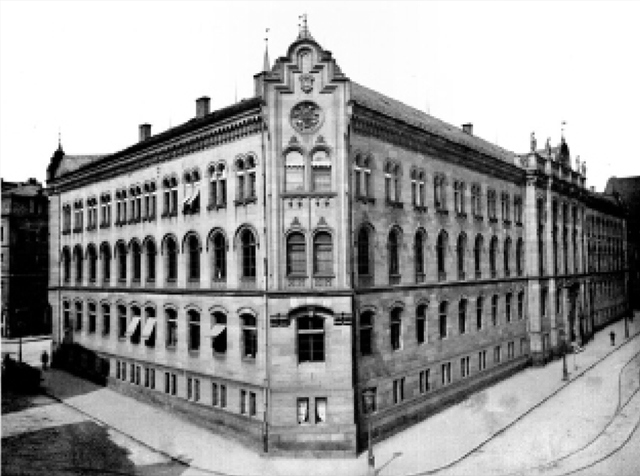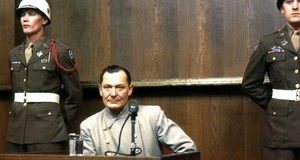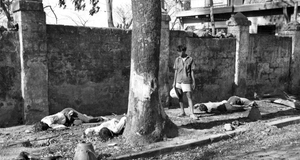From Cornell International Affairs Review VOL. 7 NO. 2Realism Versus Idealism at Nuremburg: The Creation of the CourtAbstractThe creation of the Nuremberg Court following World War II exemplified international cooperation, particularly between the Great Powers: the United States, France, the Soviet Union, and Great Britain. Expounding the benefits of justice and the rule of law, the Nuremberg Trials are often viewed as the pinnacle of Wilsonian idealism. However, further examination reveals the actions of the Roosevelt administration were not derived from a united Cabinet seeking to realize broad principles of humanitarian justice and equality. Instead of being a unified decision based on these values, the reasoning behind the creation of the Nuremberg Court was hotly disputed. The Court was formed for multiple reasons: to ensure that Germany could not claim restitution for wartime losses; to prevent formation of a new court directed by the United Nations; and to punish Germany for its crimes. Therefore, the reasoning behind the creation of the Nuremberg Court contained realist logic. On November 20, 1945, twenty-two German officers were tried in Nuremberg, Germany, for crimes including “crimes against peace, war crimes and crimes against humanity.” The trials were held under the London Charter enacted by the Allies on August 8, 1945.1 These trials, commonly known as the “Nuremberg Trials,” set a precedent for future international criminal courts, such as the modern International Criminal Court at the Hague. While an initial understanding may assume that these actions were derived from a united Presidential Cabinet seeking principles of humanitarian justice, further examination reveals that Nuremberg Court was a point of contention in the Roosevelt administration. The Court was formed for multiple reasons: to ensure that Germany could not claim restitution for wartime losses; to prevent formation of a new court directed by the United Nations; and to punish Germany for its crimes. In order to achieve these goals, proponents used existing bureaucratic operating procedures during the creation the Court. Although ensuring American security was a goal shared by both idealists and realists at the time, the Nuremberg Trials adopted an idealist method by relying upon an international body of justice. An international judicial effort of this scale was unprecedented. This paper addresses not only the convergence between realism and idealism in terms of establishing the Nuremberg Trails, but also the importance of individuals within the administration and the influence of standard operating procedures within the military bureaucracy. Although the Nuremberg Trials provides the quintessential case of idealism in foreign policy, it also contains realism. The creation of the Nuremberg Court exemplified international cooperation, particularly between the great powers: the United States, France, the Soviet Union, and Great Britain. In political theory, idealism relies upon a Lockean perspective, promoting international coalitions and humanitarian concerns, and occasionally evoking abstract morals such as justice.2 In his book Special Providence, Walter Mead further develops the notion of idealism, stating that Wilsonian idealists “believe that the United States has both a moral obligation and an important national interest in spreading American democratic and social values throughout the world, creating a peaceful international community which accepts the rule of law.”3 Secretary of the Treasury Henry Morgenthau, Jr. whose post-war plan of deindustrializing Germany was characterized by realism. Founded on the principles of cooperation and punishment, the Nuremberg Court presented both realist and idealist values. Mead’s description of Wilsonianism illustrates the importance idealists place upon “morals” and “social values,” suggesting that international actors should not merely act in their own self-interest but rather for the larger community or purpose.4 In addition, by seeking a “peaceful international community,” idealists favor international coalitions in order to encourage global cooperation and promote justice. This paper defines idealism as the promotion of morals and multinational organizations in order to achieve a peaceful international community in accordance with Wilsonian idealism. In contrast to idealism, realism originates from a Hobbesian perspective,5 viewing international relations as a power struggle and focusing on each state’s interests instead of broad moral principles. Joseph Nye and David Welch write that “for the realist, the central problem of international politics is war and the use of force, and the central actors are states.”6 By focusing on “force,” realists emphasize security and military solutions to international problems. Regarding “war” as “central” allows realists to be more inclined to use force than idealists. The realist viewpoint often leads to a distrust of international coalitions because, on a state level, coalitions can be manipulated to achieve individual states’ goals instead of broader principles. This paper defines realism as the view that force is the primary mechanism for ensuring stability. Thereby, realism includes establishing justice by ensuring the predominance of the state. Although discussion of theories such as realism and idealism may appear abstract, their implementation inevitably involves government bureaucracies. Bureaucratic institutions contain a set of standard operating procedures that in practice can be either favorable or unfavorable for the realization of a given initiative. Graham Allison and Philip Zelikow emphasize the importance of organizational bureaucracy for shaping foreign policy, stressing that governments consist of “loosely allied organizations, each with a substantial life of its own.”7 Bureaucracies sometimes behave as their own actors within a government. When implementing a plan, political leaders must work with bureaucracies to accomplish any substantial change. The Nuremberg Trials illustrate that idealist policies with realist aspects can be practically implemented with both new and existing bureaucratic systems. Furthermore, the implementation of the plan for the Nuremberg Trials was successful due to operative procedures of the military, underscoring the importance of bureaucracy within foreign policy regardless of political ideology. Prior to the end of the war in 1945, the Allies discussed the repercussions for German leaders responsible for the Holocaust and the war. According to the Moscow Conference of 1943, the United States, China, Great Britain, and the Soviet Union agreed upon the necessity for punishing enemy leaders, stating in the Moscow Declaration that Germans who committed atrocities should be “judged and punished.” 8 However, the methods of punishment were not determined. Within the Roosevelt administration, individuals such as Secretary of the Treasury Henry Morgenthau, Jr. and Secretary of War Henry L. Stimson presented competing plans to promote justice. In addition to Roosevelt’s direct Cabinet, other government bureaucracies were also influential in formulating a methodology for punishing the German war criminals. Stimson relied heavily upon his military advisor Murray Bernays, who provided the legal foundation for charging the German leaders with conspiracy to wage aggressive war.9 Instead of a coherent administrative viewpoint shared by all, discussion within the Roosevelt administration was marked by dissension, illustrating the contrasting ideologies associated with a cabinet composed by political rivals. The Morgenthau plan exemplified a hawkish and realist perspective. Morgenthau called for the deindustrialization of Germany and executing Nazi leaders without trial.10 By relying upon the necessity of summary execution, Morgenthau’s view centered on a power paradigm where the German leaders must be exterminated to provide for the security of Europe and avoid another German threat. He exemplified an extreme realist, hawkish perspective through his perception of the necessity of force. The Morgenthau plan included using German prisoners of war (POWs) to rebuild Europe and destroying German industries.11 By relying on examples of U.S. military might and stringent penalties for its enemies, the Morgenthau Plan focused on absolute victory and absolute punishment. Contrasted with the Morgenthau plan, Stimson’s plan appears idealistic and Wilsonian, lacking a foundation in realism due to his reliance on international coalitions. Stimson and Bernays formulated a plan to ensure justice and due process of law as opposed to the summary execution of German officials suggested by Morgenthau. Stimson’s plan emphasized the necessity of an international body to judge the leaders of the Third Reich.12 By relying heavily upon international cooperation and principles of justice, Stimson’s plan proves idealistic. Stimson sought to prosecute the Nazi leaders for their “purposeful and systematic pattern” to achieve “world domination”13 in addition to their heinous crimes. In an article for Foreign Affairs, Stimson later reflected upon the “moral position” of the Allies who “gave the Nazis what they had denied their own opponent – the protection of the Law.”14 By suggesting that moral reasoning lead to the formation of the Nuremberg Court, Stimson’s viewpoint rests upon the desire for ideals and moral principles, instead of pragmatism and realism. He hopes for a “world of law and peace,”15 in contrast with the realist notion of the balance of power and states acting in their own interests. By discussing collective action, Stimson made his own motives appear idealistic. Stimson’s policy specifically sought to inhibit Germany from claiming duress16 as stated in a memo from Secretary Hull and Secretary Stimson to President Roosevelt. Unlike the Morgenthau plan, which sought systemically to destroy Germany and thereby obviate any future German threat, Stimson wanted to dissuade the Germans from their post-WWI claims of unfair treatment in the Treaty of Versailles.17 This is important because previously Germany used the coercion of the Treaty of Versailles to invigorate domestic nationalism, as illustrated in Hitler’s Mein Kampf.18 By proposing a fair trial, Stimson presented an idealist position and illustrated the disagreement within the administration as to the methods of stopping Germany from instigating future wars. In addition to the Morgenthau plan, the Department of State issued a memorandum promoting a method where “Nazi criminals could be perfunctorily ‘tried and executed.’” Stimson wrote in his diary that the Cabinet was “irreconcilably divided.”19 Morgenthau attempted to elicit support from Hull, but, according to his diary, felt Hull was “holding back on him,”20 illustrating complex lines of dissension. Both Morgenthau and Hull wanted harsh repercussions for Germany; however, Hull wanted a trial according to the law. When compared with the more realist approach of punishing the powerful, Stimson’s plan represents an idealist approach mixed with a desire to avoid forcing Germany into desperation. Besides its aim to prevent claims of duress, the Nuremberg model also originated from the desire to ensure punishment for crimes. Similarly to both Morgenthau and Hull, Stimson stressed the importance of holding Nazi leaders culpable for the war and the atrocities committed. In a memo co-authored with Hull, Stimson writes, “separate prosecution of large numbers of individuals will only make good the Nazi assumption that their crimes would go unpunished.”21 In order to hold the Nazi leaders accountable, Stimson’s plan involved a small trial, which targeted the top Nazi leaders individually. 22 By believing that an international trial of the Nazi leaders would create justice and security, Stimson represented an idealist perspective. Relying upon law, not force, to provide satisfactory retributions for German leaders illustrates how Stimson differed from Morgenthau. Yet, his rationale for trying the culprits in one large group instead of a series of individuals did not originate from an idealist belief that these individuals represented the entire Nazi Party, but rather from a practical belief that a small trial of individuals would provide the maximum amount of culpability for those responsible. While representing idealist principles in its goals and methods, Stimson’s plan also contained realism in its desire to retain control over the courts. Before the President chose Stimson’s plan, the United Nations (which at the time was essentially the collection of states fighting Germany) sought to create its own body for trying war criminals. A memo sought to create a permanent court in the United Nations, called the “United Nations War Crimes Commission,” and it is designated for the persecution of war crimes.23 The Great Powers were appalled. When responding to the UN War Crimes Commission, the British Embassy wrote, “His Majesty’s Government is strongly opposed to this suggestion.”24 The British embassy stated that it desired to try those who committed offense against Great Britain in its own courts, but could find multinational tribunals “useful,” suggesting their creation after the occupation of Germany. The British Embassy’s proposal parallels Stimson’s own plan, illustrating the necessity for international cooperation in the formation of these courts. Yet, this perspective also exhibits realism in its desire not to use umbrella international organizations such as the United Nations. Instead, both Stimson and Great Britain’s plans relied upon agreement between the Great Powers. When given the choice of more expansive multilateral cooperation, the Allies preferred to control the trial, illustrating a realist approach to ensuring their dominance of the trial.Continued on Next Page » Suggested Reading from Inquiries Journal
Inquiries Journal provides undergraduate and graduate students around the world a platform for the wide dissemination of academic work over a range of core disciplines. Representing the work of students from hundreds of institutions around the globe, Inquiries Journal's large database of academic articles is completely free. Learn more | Blog | Submit Latest in International Affairs |





















